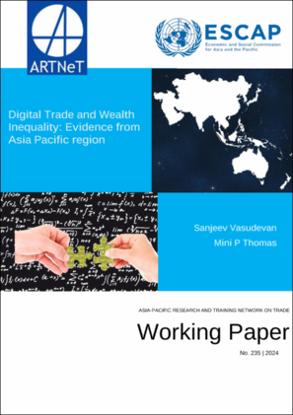Digital trade and wealth inequality : evidence from Asia Pacific region

This paper examines the impact of digital trade on wealth inequality for 40 developed and developing member countries of the UNESCAP Asia Pacific region, for the period from 2005-2021. Data on digital trade, measured using two indicators, namely, trade in digitally deliverable services and trade in ICT goods, is obtained from UNCTAD. Data on within-country wealth inequality, measured using two indicators, namely, wealth share of the top 1 percentile and top 10 percentile of the adult population, is sourced from the World Inequality Database. The overall trend in digital services trade restrictiveness and wealth inequality within the Asia Pacific region is analysed. Based on a rich panel dataset inclusive of standard control variables, this study then estimates the digital trade-wealth inequality nexus with the help of panel fixed effects and instrumental variable estimation techniques. The following key findings emerge: First, we find empirical evidence in support of the positive and significant impact of international trade, in both digitally deliverable services and ICT goods, on within-country wealth inequality in the Asia Pacific region. Second, however, we observe marked heterogeneity between developed and developing member countries of ESCAP, with the effect of digital trade on wealth inequality turning out to be significant for developed countries and insignificant for developing countries. Policy recommendations for streamlining digital trade, to achieve the Sustainable Development Goal of reduced wealth inequality are put forth based on our findings. Elimination of monopolistic and restrictive digital trade practices, and improving the regulatory framework pertaining to digital trade can help mitigate increasing wealth inequality in the developed countries. On the other hand, removal of obstacles faced by small and medium-scale enterprises, youth and women entrepreneurs in accessing and participating in digital trade and digital platforms can go a long way in bringing down wealth inequality in the developing economies, particularly in the Asia-Pacific region.
